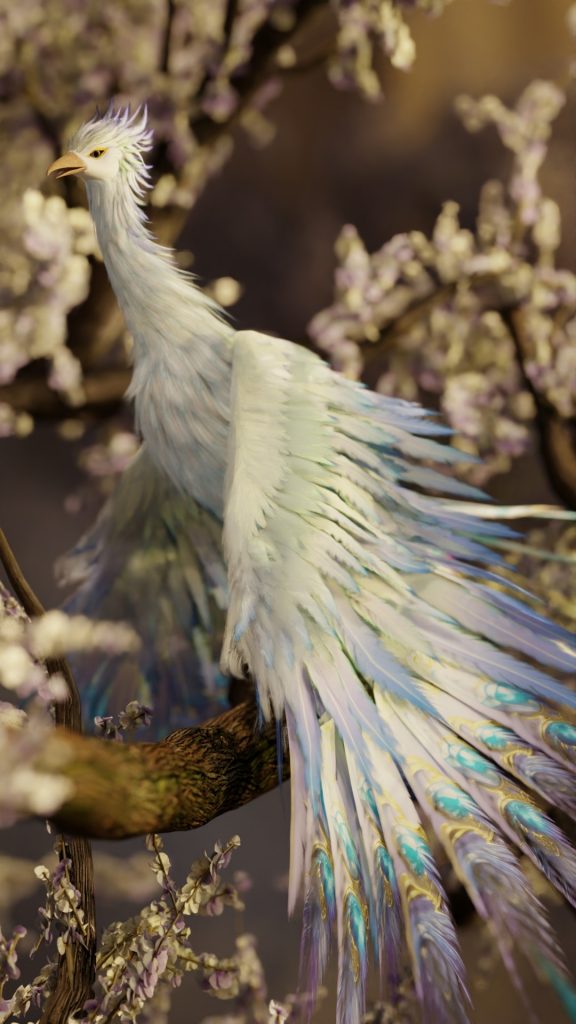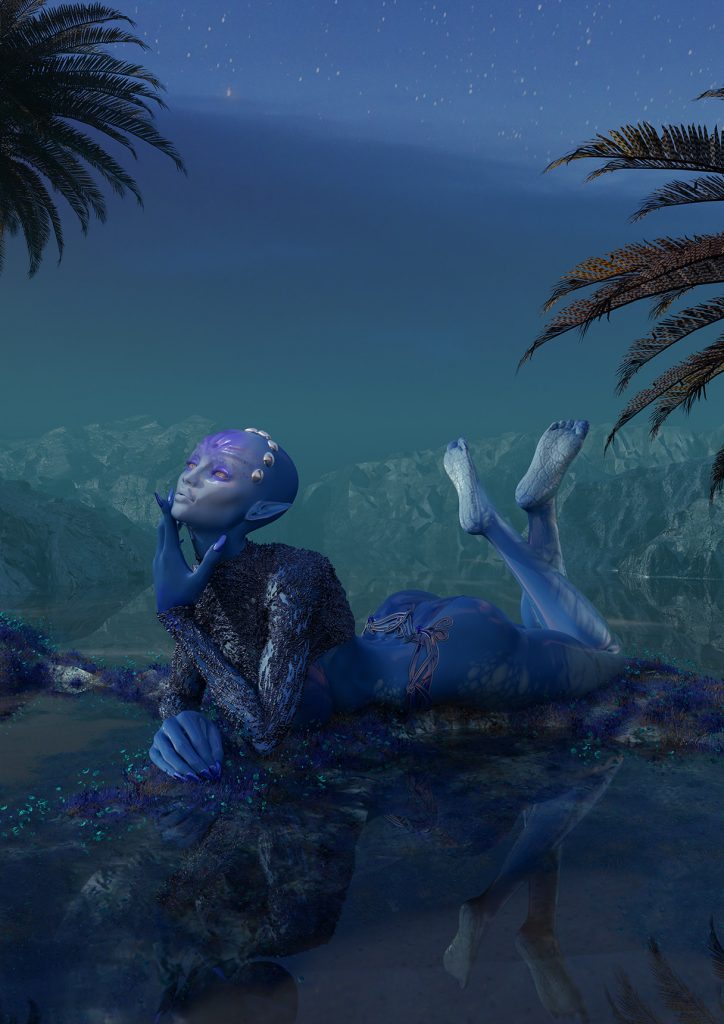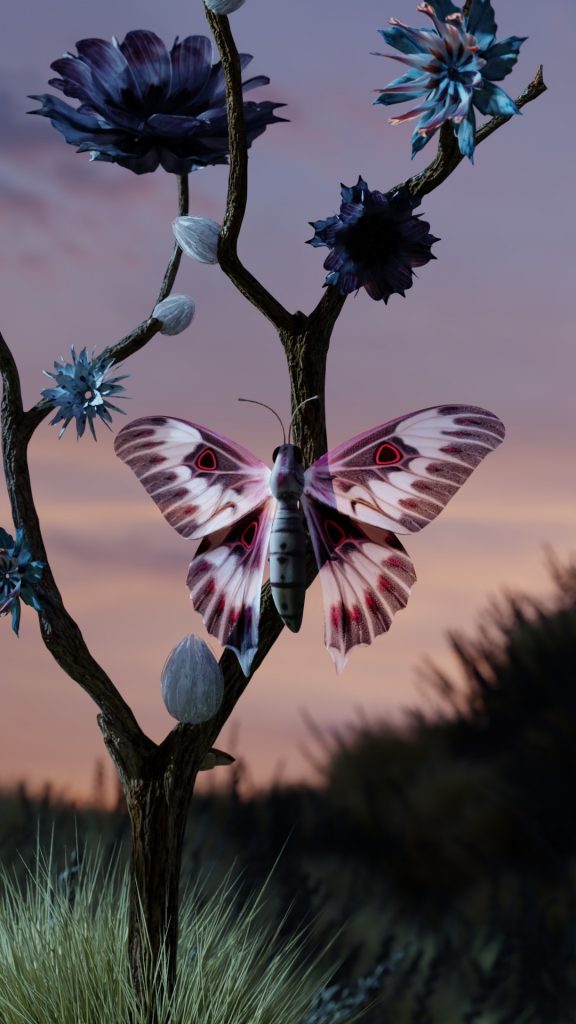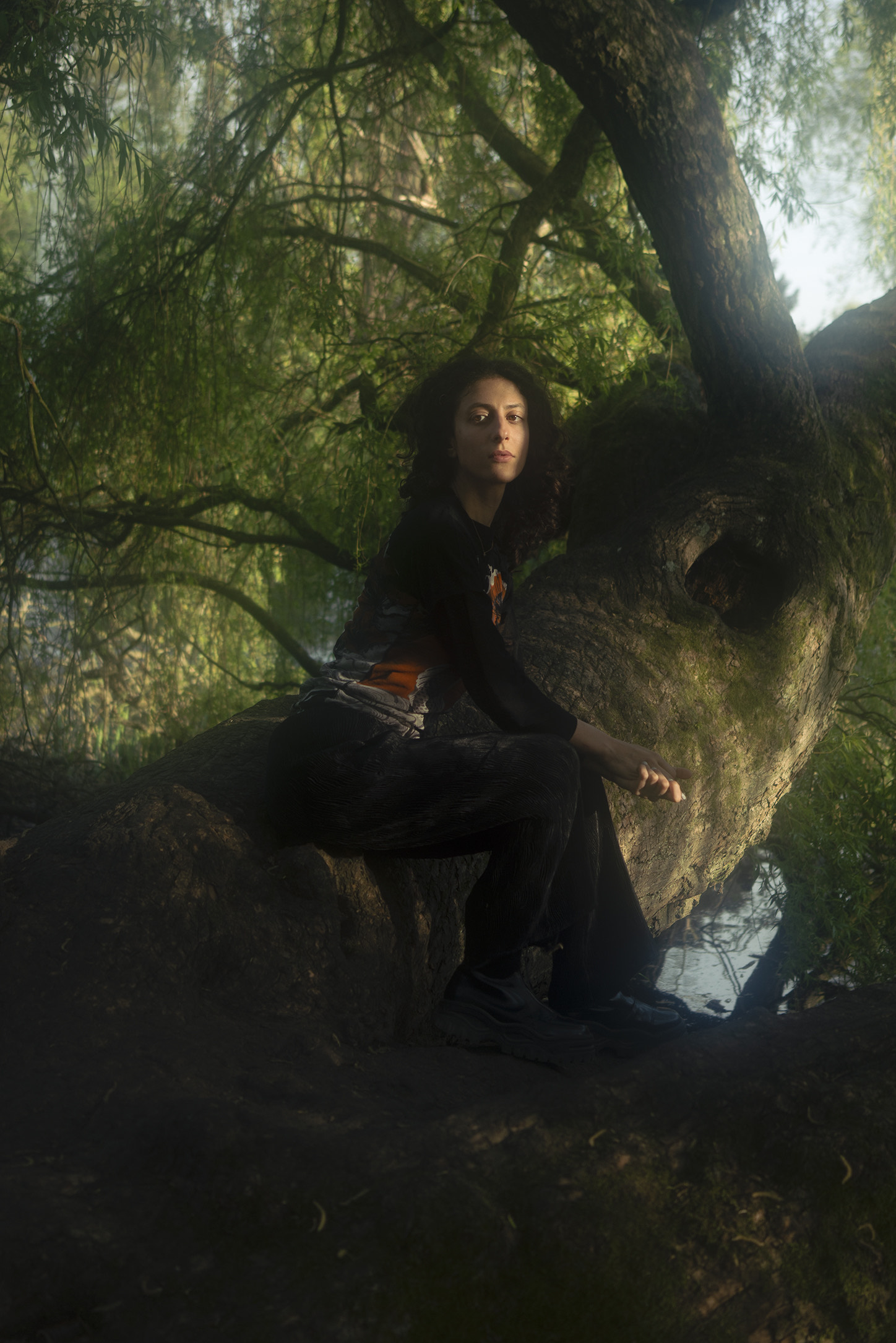ROXI BASA
Generazione Critica: Your artistic journey started in fashion photography before evolving into 3D art and immersive world-building. How did this transition shape your approach to visual storytelling, and what drew you to the digital realm?
Roxi Basa: I’ve always been a very creative person, constantly searching for a medium to express myself. When I was younger, I wrote and drew a lot. While working in fashion photography, I wasn’t completely satisfied. Expressing big ideas was quite complicated without substantial budget or resources. There’s an interesting contradiction in my journey: I started exclusively with analog film photography, and now I work with cutting-edge technology. The pandemic became a pivotal moment for me, I was bored, discovered Blender, and immediately felt drawn into a new world, I’d found a creative realm where my imagination was the only limitation.
My background in photography proved invaluable in this transition. Years of collecting visual references and developing my eye for light, composition, and color gave me a strong foundation for 3D art. I have clarity about my artistic direction and vision. While my creative tools have dramatically changed, the essence of my visual language remains consistent. The references and aesthetic sensibilities I developed in photography continue to inform my digital work, even as they naturally evolve and expand in this new medium.
GC: Your works balance fantasy, surrealism, and strong narrative elements, crafting visually stunning yet deeply evocative pieces. What are the key inspirations behind your practice, and how do you go about constructing the alternate realities that define your style?
RB: My creative inspiration draws from diverse sources, with speculative biology standing at the forefront, particularly Douglas Dixon’s work. An essential influence was The Animals of the Future, a book and DVD my father gave me as a child that sparked a a big fascination. Interestingly, the creative elements that captivated me in childhood continue to resonate with me today.
Ernst Haeckel’s scientific illustrations and filmmaker Satoshi Kon’s surreal visual storytelling have also profoundly shaped my aesthetic sensibilities. I’m naturally drawn to mythological narratives, fantastical stories, and the mysterious. The natural world serves as a never-ending source of ideas. I regularly immerse myself in forests and watch a lot of nature documentaries to feed my creative process. I also enjoy documentaries about the mind and different kinds of knowledge, they help broaden my perspective and spark new ideas.
I must also mention how anime has significantly influenced the architecture of my fantasies, providing rich sources of dreamlike imagery and poetic inspiration that continuously inform my creative vision.
Dario Argento’s cinematic approach, especially his distinctive use of lighting and musical elements, has significantly influenced my visual language.
My world-building process isn’t formulaic, it requires solitude and mental wandering to fully develop. However, one consistent element threads through all my work: each piece originates from a specific emotion I’m driven to express. This emotional core serves as the foundation upon which I construct my alternate realities.

© Roxi Basa, 2025, video-still, courtesy the artist.
GC: Anatomies of the Future presents an otherworldly being that blurs the lines between human, alien and aquatic beings. What was the conceptual foundation for this character, and how do these portraits reflect your vision of identity beyond the limits of reality? What is about the siphonophores that caught your attention?
RB: Recently, I’ve been deeply influenced by speculative biology, particularly focusing on animals, and I found it compelling to extend this exploration to “human” forms. Anatomies of the Future celebrates diversity, fluidity, and transformation. In this imagined reality, human forms transcend current biological constraints. Adaptation and augmentation enable self-defined existence, transforming the body into a canvas for identity expression rather than a fixed state. This project envisions an inclusive future where humanity isn’t bound to a singular form but evolves toward multiplicity, connection, and symbiosis with nature.
I discovered siphonophores while watching a documentary, and they immediately captivated me. These enigmatic deep-sea organisms challenge our conventional understanding of what constitutes a singular body. Unlike solitary creatures, siphonophores exist as super-organisms, complex colonies of specialized entities functioning in perfect harmony. They embody a fascinating biological modularity, where distinct segments communicate and perform specialized tasks, creating a living network of synchronized intelligence. Their bioluminescent communication system, used for hunting and interaction, became the conceptual foundation for reimagining human anatomy in Anatomies of the Future. I found this incredibly inspiring and love the idea of emulating these creatures and their remarkable properties. In my view, our future technological and biological development will increasingly draw inspiration from existing biological systems, mimicking nature’s own elegant solutions that have been refined through millions of years of evolution.
GC: Your creations feel like portals to parallel dimensions, where the digital medium is not just a tool but an integral part of the experience. How do you see emerging technologies, such as 3D modeling, AR, or VR, shaping the future of artistic expression?
RB: Emerging technologies are radically transforming our relationship to artistic creation. Tools such as 3D modeling, augmented reality and virtual reality blur the boundary between the real and the digital, becoming part of the artwork rather than a mere technical tool.
These developments open up new narrative possibilities. The public is no longer a passive viewer, but an active participant who can enter imaginary worlds, explore them from the inside, and shape narratives through their interactions. The artist’s role thus shifts from that of creator of finished objects to that of designer of experiences and ecosystems, inviting engagement and connection in ways previously impossible.
As these technologies develop, I believe the boundary between art and life will become increasingly fluid. Art will transform from something we simply observe into something we inhabit, responsive environments that evolve with us. This evolution represents an exciting frontier, the potential of which we’ve only just begun to glimpse.

© Roxi Basa, 2025, video-still, courtesy the artist.
GC: Nature, mystery, and the unseen seem to play an important role in your work. As well as an interest into the transhumanist possibilities of our bodies. How do you weave these elements into your narratives, and do you see your work as a way to reconnect with a sense of wonder and exploration?
RB: Nature and mystery fuel my creative vision. I’m constantly drawn to the inexplicable, the partially hidden, things that suggest deeper layers of meaning than we can immediately perceive. The potential evolution of bodies and realities captivates me, especially when technology and nature intersect. These fluid spaces, where forms are not permanently fixed but can transform and merge into one another, are where my imagination thrives. These concepts seep naturally into the dreamlike worlds I build.
When I create, I’m essentially building my ideal reality, the world I’d like to see. These imagined spaces become more tangible through my work, and I invite others to enter them. I’m trying to recapture the childlike wonder we feel before we develop the compulsion to categorize and explain everything.
I want to create environments that disorientate in a positive way, that surprise, that change perspectives. My work embraces mystery, both in nature and in ourselves, and explores what we might become when we allow ourselves to exist in that blurred space between what is and what might be. Extraordinary beauty exists everywhere around us, if only we choose to see the world differently.
GC: Your projects often involve collaborations with brands and businesses, merging artistic vision with commercial storytelling. How do you navigate the balance between maintaining creative freedom while designing immersive experiences for different audiences? Also, and this is very interesting, your website is conceived as a series of worlds to explore: there are tales, portals, realms. Can you elaborate also on this particular organization?
RB: Balancing creative freedom with the needs of brands and businesses is always an ongoing conversation. For me, it starts with finding a shared vision, understanding what the brand values, and then seeing how it can intersect with my own universe. I’m always interested in pushing beyond conventional “commercial” storytelling, to create something immersive and meaningful, where both the brand’s message and my artistic voice feel authentic.
My website is the result of several weeks and months of research to create something that truly represents me and extends my creative vision. I didn’t want a traditional site, I wanted to fully embrace the concept of immersion in an alternative universe, a realm where projects become Tales and form a coherent whole within my visual identity. I wanted to create a complete experience that can be a kind of world-building, where people are free to imagine new possibilities and, for a moment, step into a different reality. This supports my continuing mission to inspire people’s dreams and transport them into my imagination.

© Roxi Basa, 2025, video-still, courtesy the artist.

